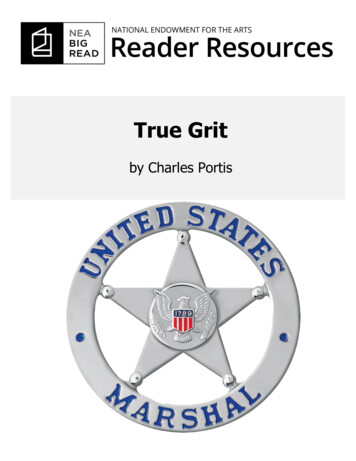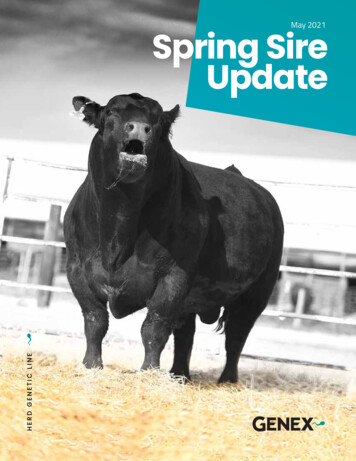
Transcription
True Gritby Charles Portis1
Table of ContentsTrue GritAbout the Book. 3About the Author . 4Historical and Literary Context . 6Other Works/Adaptations . 7Discussion Questions. 9Additional Resources . 10Credits . 11“I have never beenone to flinch orcrawfish when facedwith an unpleasanttask.”PrefaceFrom the moment it was published, Charles Portis's True Gritearned acclaim from critics as a classic Western tale. In thedecades since, readers of all ages and fans of all literarygenres have fallen in love with the indelible voice of MattieRoss, as she recounts her youthful quest to avenge themurder of her father with the aid of a down-at-heels federalmarshal named Rooster Cogburn. The rousing adventurestory inspired two award-winning films, but on the page,readers will discover fully the rich humor, inventive prose,and compelling characters that have made the book amasterpiece of American storytelling.What is the NEA Big Read?A program of the National Endowment for the Arts, NEA BigRead broadens our understanding of our world, ourcommunities, and ourselves through the joy of sharing agood book. Managed by Arts Midwest, this initiative offersgrants to support innovative community reading programsdesigned around a single book.A great book combines enrichment with enchantment. Itawakens our imagination and enlarges our humanity. It canoffer harrowing insights that somehow console and comfortus. Whether you’re a regular reader already or making upfor lost time, thank you for joining the NEA Big Read.NEA Big ReadThe National Endowment for the Arts2
About the BookIntroduction tothe BookIn the first line of True Grit,Charles Portis introduces thereader to the engaging voiceof Mattie Ross, narrating fromold age the great adventure ofher life: "People do not give itcredence that a fourteen-yearold girl could leave home andgo off in the wintertime toavenge her father's blood butit did not seem so strangethen, although I will say it didnot happen every day."In language straightforward but strongly her own, full offeeling but unsentimental, she goes on to relate the tale ofher search for her father's murderer, "a coward going by thename of Tom Chaney," during a hard winter across the"Choctaw Nation" in the last quarter of the nineteenthcentury. To aid her in her quest, she seeks a man with aquality she calls "true grit" and thinks she finds him inRooster Cogburn, a shabby and overweight but affablefederal marshal. Also seeking Chaney, for other crimes, isLaBoeuf, a proud, young Texas Ranger, who enters into asometimes uneasy partnership with the pair.As the three track the killer across the still-untamedterritory, they find themselves challenged by the landscapeand its natural perils, by the deadly enemies they face, andultimately by one another and their own fears.Portis vividly recreates the roughness of an America that isbarely a hundred years old and still deciding what kind ofcountry it will be. A portrait of a specific time, it neverthelessexudes a mythic timelessness. In his unforgettablecharacters, he explores the meaning of friendship, courage,and fidelity to a moral code. Even as he plumbs these broadthemes, the action never flags and the tale bristles withhumor.Major Characters in the BookMattie RossRaised on a farm in Yell County, Arkansas, Mattie is resoluteand resourceful in seeking justice for the murder of herfather. Headstrong, independent, and witty, Mattie—even atfourteen—insists on eventually facing down Tom Chaneyherself, carrying her father's "Colt's dragoon" to kill him evenif the law would fail to do so.Reuben J. "Rooster" CogburnA former Confederate soldier, Rooster has become a federalmarshal who patrols the Indian Territory. Prone to drinkingbouts and the administration of his own brand of justice thatsome consider "pitiless," he is employed by Mattie to trackdown her father's murderer.LaBoeufProud, handsome, and something of a dandy in his"clanking" spurs, the Texas Ranger is seeking Tom Chaneyfor the murder of a Texas state senator. He clashes withRooster over their differing approaches to the pursuit andsuffers Rooster's antipathy toward the Rangers.Tom ChaneyAn itinerant hired man on Frank Ross's farm, Chaney killsand robs his employer on a trip to Fort Smith to buy horsesand then flees to the Indian Territory. He is distinguished bya black mark on his cheek, which he received after a manshot him in the face, lodging gunpowder under his skin.Lucky Ned PepperLong sought by Rooster and earlier wounded by him in thelip, Pepper heads a band of outlaws, which Tom Chaneyjoins after killing Frank Ross.Little BlackieThe spirited pony carries Mattie, who calls him her "chum,"over the Winding Stair Mountains on the quest to find TomChaney and eventually plays a crucial role in her verysurvival.In the near half-century since it was first published, readersof all ages—including Portis's fellow writers, who admire thecraft as much as the rousing story—have come to treasure itas a classic, not just of the Western genre but in all ofAmerican literature.NEA Big ReadThe National Endowment for the Arts3
About the AuthorCharles Portis(b. 1933)In "Combinations of Jacksons"(1999), the one piece ofautobiography he haspublished, Charles Portisdescribes a happy childhoodroaming the rural landscapeof south Arkansas, coolingwatermelons in streams,devouring comic books, andlistening to stories fromrelatives like his great UncleSat, "a strong and fluenttalker with far-rangingopinions."from The Overlook Press, and a collection of his journalism,short stories, travel writing, and drama, Escape Velocity: ACharles Portis Miscellany, was published in 2012 by theButler Center for Arkansas Studies.Portis's work has long attracted a cultish following, especiallyamong fellow writers such as Calvin Trillin, Donna Tartt,George Pelacanos, Roy Blount Jr., and the late Nora Ephron,who recognize the mastery in making such a difficult thingas comedy appear so effortless.Portis of ArkansasCharles Portis. Image courtesyof Jonathan Portis.His father was a school superintendent and his mother ahomemaker who was also a "good poet with a good ear," ashe described her in a rare 2001 interview. After graduatingfrom Hamburg High School in 1951, Portis enlisted in theMarine Corps and served overseas during the Korean War,as did Norwood Pratt, a character from his first novel,Norwood (1966).The G.I. Bill allowed Portis to attend the University ofArkansas, where he majored in journalism which he chosebecause he "thought it would be fun and not very hard,something like barber college." After graduating, he workedfor several newspapers, including the Commercial Appeal inMemphis, the Arkansas Gazette in Little Rock, and the NewYork Herald Tribune, where he covered the civil rightsmovement, worked in the newsroom with Tom Wolfe andJimmy Breslin, and eventually became London bureau chief.In 1964, he left that job and moved back to Arkansas to tryhis hand at fiction. His first novel, Norwood (1966), receivedglowing reviews, and his next one, True Grit (1968), becamea bestseller and a star vehicle for John Wayne, whose 1969portrayal of Rooster Cogburn earned him his only Oscar.A private man who rarely grants interviews, Portis has sincelived a quiet life in Little Rock, with occasional driving tripsto Mexico and points west, while producing three morenovels, The Dog of the South (1979), Masters of Atlantis(1985), and Gringos (1991). Wildly different from oneanother but consistently displaying deadpan comedy andempathetic satire, these novels were difficult to categorize(especially for readers who knew Portis only as working inthe Western genre) and went out of print until the late1990s, when fans like critic Ron Rosenbaum beganchampioning them. All of Portis's novels are now availableNEA Big ReadThe National Endowment for the ArtsIn Charles Portis's third novel, The Dog of the South,narrator Ray Midge proclaims: "A lot of people leaveArkansas and most of them come back sooner or later. Theycan't quite achieve escape velocity." This comment, bothfunny and surprisingly poignant, refers to the mysteriousgravitational pull of the particular place called Arkansas.While wandering off and returning, a theme as old as theOdyssey and one of the themes of True Grit, isn't completelyunique to this state, it certainly applies to Charles Portis.When Portis has allowed an author biography on his bookjackets (the first editions of The Dog of the South andMasters of Atlantis had none), they have sketched his careerthusly: Born and educated in Arkansas, he served in Koreaas a Marine and worked as a journalist in Memphis, LittleRock, New York City (often traveling South on the civil rightsbeat in 1963), and London, where he was bureau chief ofthe New York Herald Tribune. He moved back to Arkansas in1964, and except for road-trip research in Mexico andelsewhere, he's remained there ever since, working as afreelance writer.Novelist and journalist Tom Wolfe, his colleague at theHerald Tribune in the early 1960s, famously summed upPortis's return to Arkansas in the introduction to aninfluential collection called The New Journalism: "Portis quitcold one day and moved into a fishing shack in Arkansas.In six months he wrote a beautiful little novel calledNorwood. Then he wrote True Grit, which was a best seller.The reviews were terrific He sold both books to themovies He made a fortune A fishing shack! In Arkansas!"Despite Wolfe's astonished italics and exclamation points,Arkansas was a good place to go to work, far enough fromboth coasts as to be invisible to them. Without thedistracting noise emanating from literary fashion inManhattan or the movie world in Hollywood, a writer inArkansas circa 1964 could go peacefully about the dailygrind of making perfect novels. Portis produced five.How perfect are they? As opposed to the output of a writerlike Robert Penn Warren, who wrote one generally4
acknowledged great novel and many lesser works, Portiswrote at least one great novel, True Grit, and four maybebetter ones. In an essay that appeared in the Believermagazine in 2003 (included in the recent collection EscapeVelocity: A Charles Portis Miscellany), novelist Ed Park sumsit up this way: "He has written five remarkable, deeplyentertaining novels (three of them masterpieces, thoughwhich three is up for debate)."Curiously, Arkansas is not fundamental to the imaginativeworld of his novels in the way that Mississippi is for WilliamFaulkner or Los Angeles for Raymond Chandler. Both MattieRoss and Ray Midge, for instance, hail from Arkansas, buthave their adventures far afield. If Arkansas has a claim onPortis, it is as the place where he learned to listen. Hisfather's side of the family "were talkers rather than readersor writers. A lot of cigar smoke and laughing when my fatherand his brothers got together. Long anecdotes. The spokenword."And in the one piece of direct memoir he has written so far,"Combinations of Jacksons," he describes how his greatuncle Sat discoursed at length on many topics from WorldWar II to hunting and "may well have been the last man inAmerica who without being facetious called food 'vittles'('victuals,' a perfectly good word, and correctly pronounced'vittles,' but for some reason thought to be countrified andcomical)."As far away as his imagination travels, Portis himself hasstuck fast to Arkansas and writes with great affection,outside his fiction, for its people, its history, and itslandscape. He can be said to share with Mattie Ross heropinion of its detractors, with its own exclamation point,"People who don't like Arkansas can go to the devil!"NEA Big ReadThe National Endowment for the Arts5
Historical and Literary ContextThe Life and Timesof Charles Portis1960s 1964: Portis works for the New York Herald Tribune,rising to London bureau chief.1870s 1872: Mark Twain publishes Roughing It. 1875: Judge Isaac Parker, the "Hanging Judge,"oversees the first of 79 executions during his tenure inthe U.S. Court for the Western District of Arkansas. 1876: George Armstrong Custer's troops routed byLakota and Cheyenne fighters on the Little BighornRiver in Custer's Last Stand.1880s–1890s 1882: Jesse James shot and killed. 1889: President Benjamin Harrison authorizes claimson Indian Territory land for white settlement. 1890: Buffalo population on the Western plainsreduced from 30 million to fewer than one thousand. 1968: True Grit published, after being serialized in theSaturday Evening Post. 1969: John Wayne stars in the film version of TrueGrit, for which he receives his only Oscar.1970s–1990s 1992: Unforgiven, a Western starring and directed byClint Eastwood, wins four Oscars, including BestPicture. 1998: Esquire magazine essay on Portis inspires TheOverlook Press to reissue Portis's out–of–print novels.2000s 2010: The Coen brothers' version of True Gritreleased. 2012: Two decades after Portis's last novel, EscapeVelocity published.1900s–1910s 1902: Owen Wister publishes The Virginian, a novelromanticizing 1870s cowboy life in Wyoming cattlecountry. Oklahoma enters the Union in 1907; Arizona and NewMexico follow in 1912.1930s 1933: Charles Portis born in south Arkansas. 1939: John Ford directs Stagecoach, his first Westernto use sound, starring John Wayne.1940s–1950s 1946: Portis's great–grandfather Alexander Waddell,who fought for the South in the Civil War, dies at age99. 1953: Shane, starring Alan Ladd as a taciturngunslinger, released. 1958: Portis serves as a Marine in the Korean War,graduates from the University of Arkansas with adegree in journalism.NEA Big ReadThe National Endowment for the Arts6
Other Works/AdaptationsPortis and His Other WorksThose who know Charles Portis only as the author of TrueGrit may have wrongly assumed that he is a writer ofWesterns in the manner of Louis L'Amour. In fact, aswonderful and popular as True Grit is, many critics and fansfeel that his literary reputation ultimately will rest on hisother four novels, which are more directly comic and genredefying.His first novel, Norwood (1966), follows Norwood Pratt, aKorean War vet, auto mechanic, and aspiring country singerfrom Ralph, Texas, on an odyssey to New York City and backto recover a 70 debt from a Marine buddy. Clocking in atless than two hundred pages, the book offers a briskpicaresque through oddball America, including an encounterwith the "world's smallest perfect fat man," the liberation ofa "College Educated Chicken" named Joann the Wonder Henfrom a penny arcade, and a sort-of love story. The bookestablishes Portis's deadpan comic voice and laugh-out-loudobservational acuity, as when Norwood notices a sign on aclosed furniture store instructing patrons "to call R. T. Bakerin case of emergency" and imagines such a call: "Hello,Baker? I hate to bother you at home but I need a chair rightnow."The success of True Grit and the pigeonholing of Portis as awriter in the Western genre no doubt accounted for theinitially tepid response to his next novel, The Dog of theSouth (1979), a shaggier picaresque. In it, a newspapercopy editor, Ray Midge, sets out from his home in LittleRock, Arkansas, to Mexico in pursuit of his wife, hiscolleague she has run off with, and his prized Ford Torino.Along the twisting way to British Honduras, Midge picks upDr. Reo Symes, a fluid talker and ne'er-do-well schemerwho, as Midge observes, once "sold wide shoes by mail,shoes that must have been almost round, at widths up toEEEEEE." Midge's first-person narration propels the book toits comic heights, and it is most often cited by fans asPortis's funniest. It sold poorly until five years afterpublication, when two New York City bookstore workersbought all existing hardcover copies and filled their storewindow display with them, reviving interest.Within a year of that resurrection, Portis had another novelready, Masters of Atlantis (1985), the tale of a second-ratefraternal society, the Gnomons, founded by LamarJimmerson, who, while serving in World War I, comes upona document that he believes holds the key to the lost city ofAtlantis and its alchemical secrets. The book traces the riseand fall of the society, as various cranks engage in infightingand power plays. Both Conan O'Brien and Garrison Keillorhave listed it among their favorite funny novels, and JesseNEA Big ReadThe National Endowment for the ArtsSheidlower, editor-at-large for the Oxford English Dictionary,recently went one step further in a Tweet: "Blown away: thisis truly a great American novel."Portis's most recent novel, Gringos, was published in 1991.Less baldly comic and altogether darker, it may be his mostfully realized work of fiction in the depth of its characters,the turning of its plot, and the complexity of its moral world.Nevertheless, his trademark clarity of language and finenessof observation are everywhere. For example, the laconicnarrator Jimmy Burns, an expatriate American in theYucatan, faces a cult-like group's menacing leader, whoseAryan Brotherhood tattoo "was a rough, homemade jobdone with a pin and spit and burnt match-heads."While fans wait for another novel, they can be happy with anew compilation of Portis's previously uncollected work,Escape Velocity: A Charles Portis Miscellany (2012). Inaddition to short stories and newspaper and magazinejournalism, the book includes a previously unpublished,once-produced play, Delray's New Moon (1996), whichnovelist Glen David Gold has called Portis's "sixth majorwork."Works by Charles PortisFiction Norwood, 1966 True Grit, 1968 The Dog of the South, 1979 Masters of Atlantis, 1985 Gringos, 1991Collection Escape Velocity: A Charles Portis Miscellany, 2012This volume contains journalism, travel writing,short stories, a full-length play, and a rareinterview, as well as several essays about Portis'swork from other writers.7
The Western Film and True GritAs a genre, the Western film dates to the earliest days of themedium itself. According to cinema historian Gerald Mast,The Great Train Robbery (1903) was the single most popularfilm in moviemaking's first two decades. Its final frame of agunslinger pointing his weapon directly at the viewer andfiring shocked audiences in its day. Up until the 1930s, theWestern, and primarily silent Westerns, thrived largely assimple, pulpy action tales that set up archetypal charactersand landscapes.Early Western films evoke "vast western vistas and thedignity of the good-bad men who inhabit these spaces," asMast writes in A Short History of the Movies. The one filmthat did more than any other to change the genre from mereentertainment to cinematic art was John Ford's Stagecoach(1939). Starring John Wayne in his first major role, it wasnominated for five Academy Awards and won two.graveyard before he mounts his horse, jumps a fence, andrides away.In 2010, Joel and Ethan Coen directed a second version ofTrue Grit, also extremely popular and award–winning,earning ten Oscar nominations. Starring Jeff Bridges asRooster Cogburn, Matt Damon as LaBoeuf, and newcomerHailee Steinfeld (who was actually fourteen during filming)as Mattie, it was praised as a more "faithful" remake, mainlyin that Steinfeld's Mattie was more true to the forcefuladolescent of the book and the actors skillfully mastereddialogue that was often taken verbatim from Portis's scenes.Whatever the flaws or faithfulness of the two versions, theirpopular success, forty years apart, affirms the timelessquality of the source material and the enduring appeal of thegenre.Ford became the preeminent director of Westerns for thenext fifteen years and Wayne the biggest star; theycollaborated on classics like Fort Apache (1948), She Wore aYellow Ribbon (1949), and The Searchers (1956), which theAmerican Film Institute has named the best Western of alltime. Ford and other directors explored themes of courage,human decency, and written versus individual law. As criticRobert Warshow wrote in 1954, "The Westerner is the lastgentleman, and the movies which over and over again tellhis story are probably the last art form in which the conceptof honor retains its strength."In the 1960s, consistent with the counterculture of the time,Westerns became more morally ambiguous, glorifying theoutlaws in Butch Cassidy and the Sundance Kid andportraying graphic violence in The Wild Bunch, both from1969.That same year, Henry Hathaway directed 62-year-old JohnWayne as Rooster Cogburn in the film version of True Grit,which earned Wayne his only Best Actor Oscar. Comparedwith other Westerns in the late 1960s, True Grit had a moretraditional feel. Nevertheless, it was very popular and rankedamong the ten top-grossing films of the year. Fans of thebook complained that Kim Darby was too old for the part ofMattie Ross, and that country singer (and Arkansas native)Glen Campbell, playing LaBoeuf, was too green an actor.The film did stick largely to the plot and structure of thebook; Portis said that in the couple of days he spent on sethe noticed Hathaway often referring to a marked-up copy ofthe book. Portis also observed that the actors "had troublespeaking the (intentionally) stiff dialogue." Although he didnot write the screenplay, he did write the final scene in thefilm in which Mattie and Rooster talk in her family'sNEA Big ReadThe National Endowment for the Arts8
Discussion Questions1.Mattie says that she is looking for a man with "truegrit" to avenge her father's death. When given achoice of marshals, including one who is "straight asa string" as opposed to Rooster, who is the"meanest," why does she choose Rooster? How doyou think she would define the quality of "true grit"?2.What evidence can we find that Mattie won't abidemistreatment of anyone because of his or herbackground? What prejudices does she admit to?3.Though Mattie often seems very mature, selfassured, and tough for age fourteen, in what scenesdo we see her react in a way more like a person herage?4.Rooster admits to killing and stealing and isportrayed as a drunkard. Why does Mattie, anupright and moral Christian, have such affection andadmiration for him? Does this reveal a contradictionin her moral code?5.Do you think Mattie's account of her adventure, asshe looks back at her actions from a time decadeslater, is an accurate one? Why or why not?6.At many points during the action, Mattie, Rooster,and LaBoeuf all "stretch the blanket," exaggeratingor lying under certain circumstances. In whichsituations does the lying seem justified? Do any ofthese instances of lying or exaggeration changeyour impressions of the characters?7.In what ways are LaBoeuf and Rooster similar intheir personalities and in their beliefs about what isright and wrong? In what ways are they different?8.There's an old proverb proclaiming that there issometimes "honor among thieves." In what ways dothe outlaws and bandits encountered in the book byMattie, Rooster, and LaBoeuf display a code ofconduct that argues that they're not purely evil?9.The language of the book is vivid and colorful, yetoften unfamiliar. How does Portis keep thecharacters' dialogue authentic to the historicalperiod but make it accessible to a contemporaryreader?10. Near the end of the book, when Mattie encountersthe elderly outlaws Frank James and Cole Youngerat a "Wild West" show, she is polite to Younger butsays to James, "Keep your seat, trash!" Why doesshe view them differently and what does it sayabout her memory of her adventure?NEA Big ReadThe National Endowment for the Arts9
Additional ResourcesIf you'd like to read other books seton the American frontier, you mightenjoy: Mark Twain's Roughing It, 1872 Willa Cather's Death Comes for the Archbishop,1927 Laura Ingalls Wilder's Little House on the Prairie,1935 A.B. Guthrie's The Big Sky, 1947 Hal Borland's When the Legends Die, 1963 Wallace Stegner's Angle of Repose, 1970If you'd like to read other books inthe Western genre, you mightenjoy: Owen Wister's The Virginian, 1902 Zane Grey's Riders of the Purple Sage, 1912 Louis L'Amour's Bendigo Shafter, 1979 Larry McMurtry's Lonesome Dove, 1985 Denis Johnson's Train Dreams, 2011 Patrick deWitt's The Sisters Brothers, 2012NEA Big ReadThe National Endowment for the Arts10
CreditsWorks CitedAcknowledgmentsExcerpts from TRUE GRIT 1968 by Charles Portis.Published by The Overlook Press, Peter Mayer PublishersInc., New York, NY. www.overlookpress.com. Used bypermission of the publisher. All rights reserved.Writer: Jay Jennings. "Portis of Arkansas" adapted from hisintroduction to Escape Velocity: A Charles Portis Miscellany,Butler Center for Arkansas Studies, 2012.Gold, Glen David. "The Lure of the Oeuthre: On CharlesPortis and Flannery O'Connor." Los Angeles Review ofBooks, 18 Nov. 2012.Cover image: "US Marshal Badge" by USMS Publishing &Multimedia Services, via Wikimedia Commons.Mast, Gerald. A Short History of the Movies, fourth edition.New York, NY: Macmillan, 1986.Mast, Gerald and Marshall Cohen, eds. Film Theory andCriticism, second edition. New York, NY: Oxford UniversityPress, 1979.Park, Ed. "Like Cormac McCarthy, But Funny." Believermagazine, March 2003.Portis, Charles. Jay Jennings, ed. Escape Velocity: A CharlesPortis Miscellany. Little Rock: Butler Center for ArkansasStudies, 2012.---. "Letter from Charles Portis to William N. Black,Superintendent, Fort Smith National Historic Site," NationalPark Service, 29 May 2000.The National Endowment for the Arts was established byCongress in 1965 as an independent agency of the federalgovernment. To date, the NEA has awarded more than 5billion to support artistic excellence, creativity, andinnovation for the benefit of individuals and communities.The NEA extends its work through partnerships with statearts agencies, local leaders, other federal agencies, and thephilanthropic sector.---. True Grit. New York, NY: The Overlook Press, 2010.Reed, Roy. "Interview with Charles Portis, Little Rock,Arkansas, 31 May 2001." Arkansas Gazette Project. PryorCenter for the Arkansas Oral and Visual History at theUniversity of Arkansas, 31 May 2001.Works ConsultedFreeman, Castle, Jr. "Owen Wister." Harvard Magazine, JulyAugust 2002.Halliwell, Leslie. Halliwell's Film and Video Guide, 6th ed.New York, NY: Scribner and Sons, 1987.Arts Midwest promotes creativity, nurtures culturalleadership, and engages people in meaningful artsexperiences, bringing vitality to Midwest communities andenriching people’s lives. Based in Minneapolis, Arts Midwestconnects the arts to audiences throughout the nine-stateregion of Illinois, Indiana, Iowa, Michigan, Minnesota, NorthDakota, Ohio, South Dakota, and Wisconsin. One of six nonprofit regional arts organizations in the United States, ArtsMidwest’s history spans more than 30 years.Kokes, Gina. "True Grit [Book and Movies]." Encyclopedia ofArkansas. 22 Sept. 2011.Moore, Bryan L. "Charles McColl Portis (1933-)."Encyclopedia of Arkansas. 12 Oct. 2012.Portis, Charles. "Combinations of Jacksons," The AtlanticMonthly, May 1999.The NEA Big Read Reader Resources are licensed under a CreativeWitschi, Nicolas S. A Companion to the Literature andCulture of the American West. Malden: Wiley-Blackwell,2011.License.NEA Big ReadThe National Endowment for the ArtsCommons Attribution-NonCommercial-NoDerivatives 4.0 International Arts Midwest11
quality she calls "true grit" and thinks she finds him in Rooster Cogburn, a shabby and overweight but affable federal marshal. Also seeking Chaney, for other crimes, is LaBoeuf, a proud, young Texas Ranger, who enters into a sometimes uneasy partnership with the pair. As the three track the killer across the still-untamed










